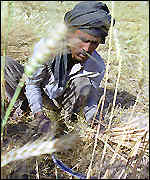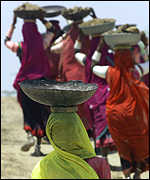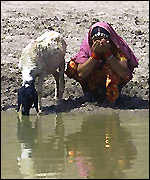
More than 13 years after the worst-ever drought of the century left its nightmarish shadow, India is once again faced with a severe drought engulfing traditionally rain-fed regions.
That the drought should
strike at a time when
the country has had 12 consecutive years of a bountiful monsoon, exposes
a sorry tale of misplaced priorities and the collapse of planning
policy.
 The government is unable to get food where it is most needed
|
It is early summer.
By the time the monsoon arrives in the last week of June (or even later), the drought-affected regions in Gujarat, Rajasthan, Madhya Pradesh, Orissa and Andhra Pradesh may well be on the way to the very distinct possibility of crippling hunger and death.
Although saddled with comfortable food grain reserves of 26m tonnes - 11m tonnes more than public distribution requirements - the government may still be unable to get food and fodder to areas where it is needed most.
Bad planning
It was certainly not unexpected.
For several years now, drought and prolonged dry spells have continued to afflict the inhospitable and harsh environs of the dryland regions, constituting nearly 70% of the country's cultivable lands.
Despite "normal" monsoons, the failure of rain in certain pockets and continuing dry spells have simply gone unreported.
With traditional forms of water storage and harvesting vanishing, and rural irrigation being completely taken over by inefficient government machinery, available ground water has been exploited indiscriminately.
Water shortages are likely to emerge as the major environmental challenge for India in the new millennium.
Local initiatives
Amidst this depressing and agonising scenario, a number of oases still dot the scorched landscape.
These are the villages where natural
resources have been well managed by local communities.
 Some villages have managed their resources well
|
Water is not only available during the crisis period, but is also being provided to scarce areas.
These are the villages which have demonstrated their resolve to protect themselves from the vagaries of nature.
And yet despite the dismal aspects of irrigation policy, the fascination of the planners for costly projects has not diminished.
Simple solutions
They have continued to overlook simple and effective methods like a series of small water storage tanks, the recharging of village wells whose water percolates the ground and replenishes underground reservoirs for drinking and irrigation purposes.
Over the years, however, traditional storage tanks and ponds have silted and dried up.
In Andhra Pradesh alone, a majority of the 52,000 water tanks have more or less silted up.
Similarly, in Karnataka, more than 43,000 ponds have simply disappeared.
Grim forebodings
In India, the total demand for water is projected to double by 2025.
Although agriculture will continue to be the biggest single user of water,
demand is growing faster in the urban and industrial sectors.
 Total demand for water will double by 2025
|
It is estimated that this demand will go up by 135% over the next 40 years, leading to many possible levels and scales of conflicts - disputes at village level, between agriculture and industry and regional disputes.
Such conflicts will also emerge as disputes between rural and urban populations, and among ethnic and economic groups.
The present drought, coming in the first year of the 21st century, therefore, is a stern warning.
| Search BBC News Online |
||
Advanced search options | ||
|
| |
|
| |
The BBC is not responsible for the content of external internet sites

